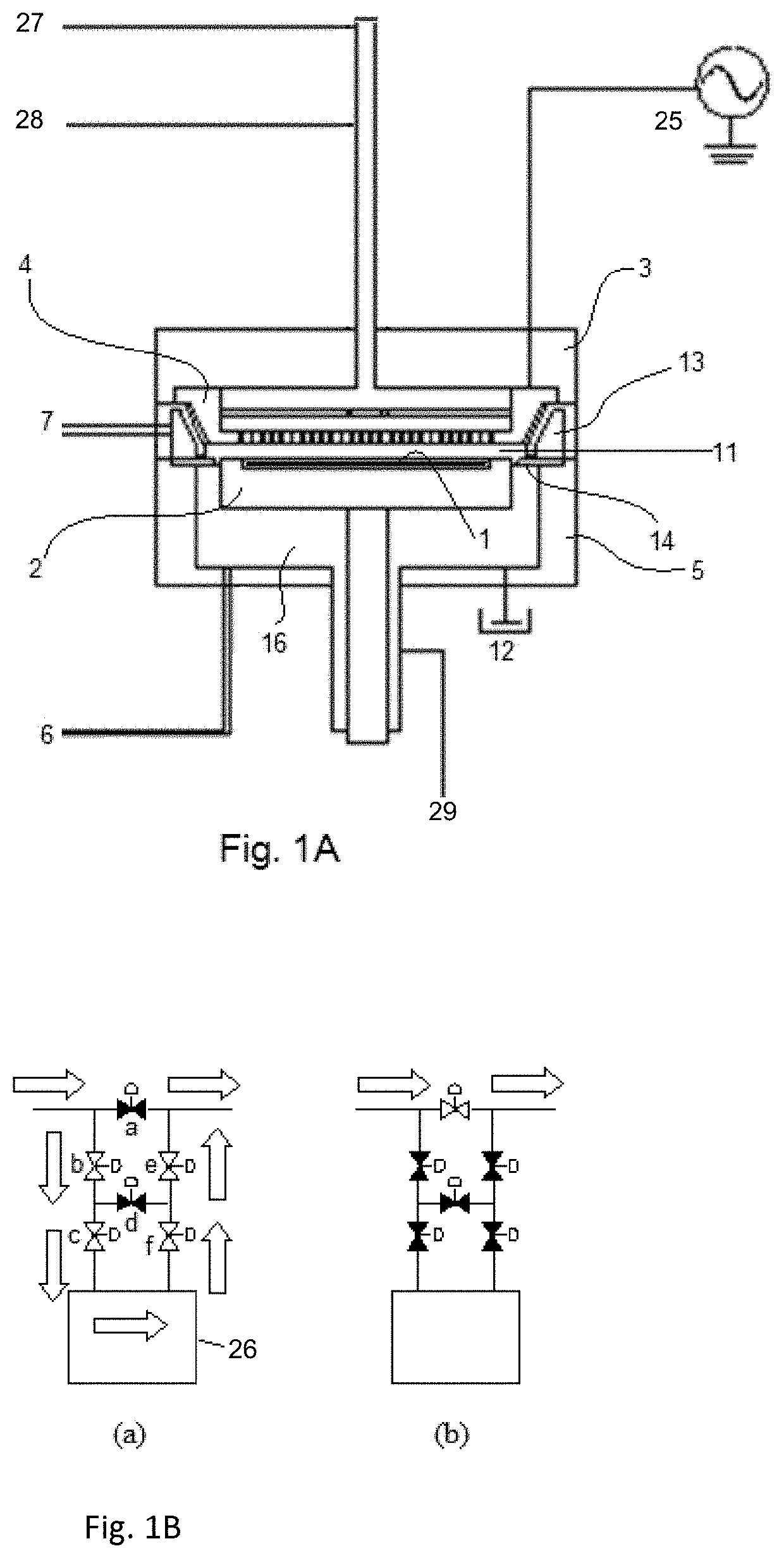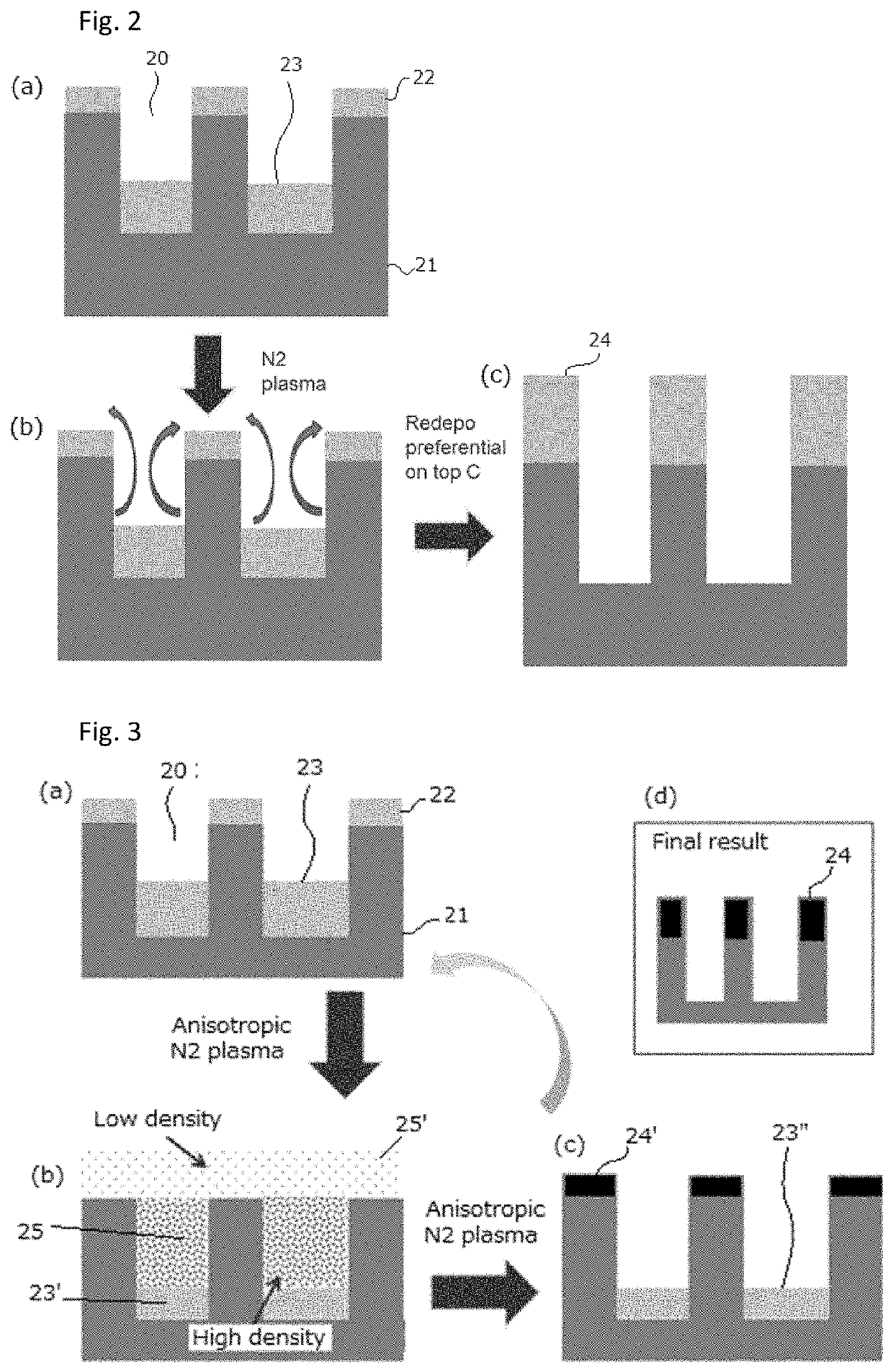Method of forming topology-controlled amorphous carbon polymer film
a topology-controlled, carbon-based film technology, applied in the direction of vacuum evaporation coating, chemical vapor deposition coating, coating, etc., can solve the problems of increasing the difficulty of void-free filling of high aspect ratio spaces (e.g., ar3), difficult to control the thickness of the film depositing on the top surface,
- Summary
- Abstract
- Description
- Claims
- Application Information
AI Technical Summary
Benefits of technology
Problems solved by technology
Method used
Image
Examples
reference example 1 (fig.4)
Reference Example 1 (FIG. 4)
[0065]A flowable amorphous carbon polymer film (a-C blanket layer) was deposited using cyclopentene at a thickness of 100-150 nm on a Si substrate (having a diameter of 300 mm and a thickness of 0.7 mm) by PEALD-like process which is defined in U.S. patent application Ser. No. 16 / 026,711 and Ser. No. 16 / 427,288, following the deposition process illustrated in FIG. 10 under the conditions shown in Table 1 below using the apparatus illustrated in FIG. 1A and a gas supply system (FPS) illustrated in FIG. 1B. Post-deposition plasma treatment was conducted on the flowable amorphous carbon polymer film under the conditions shown in Table 1 below, which was conducted in the same reaction chamber as in the deposition process, in order to evaluate film shrinkage effect by each post-deposition treatment.
TABLE 1(numbers are approximate)DepoSUS temp (° C.).70SHD temp (° C.)75Wall temp (° C.)75BLT temp (° C.)RTPressure (Pa)1100Gap (mm)14Feed time (s)0.4Purge (s)0.1RF ...
reference example 2 (fig.5)
Reference Example 2 (FIG. 5)
[0074]A flowable amorphous carbon polymer film (a-C film) was deposited on a Si substrate (having a diameter of 300 mm and a thickness of 0.7 mm) having trenches with an opening of approximately 25 to 100 nm, which had a depth of approximately 85 nm (an aspect ratio was approximately 3.4 to 0.85), by PEALD-like process in a bottom-up manner in the same manner under the same conditions as those in Reference Example 1 except that the deposition continued until the trenches were fully filled and the top surface of the a-C film became planar. Thereafter, the post-deposition plasma treatment was conducted in the same manner under the same conditions as those using O2 / Ar and N2 / H2 in Reference Example 1 except that the plasma treatment continued until all the film was removed.
[0075]FIG. 5 shows STEM photographs of cross-sectional views of the trenches, wherein raw (a) represents the trenches subjected to full-fill deposition of the flowable film, raw (b) repres...
example 3 (table 2 , fig.9)
Example 3 (Table 2, FIG. 9)
[0080]In Example 3, an amorphous carbon polymer film was formed in the same manner under the same conditions as in Example 1, and then, the nitrogen plasma treatment was conducted on the film in the same manner under the same conditions as in Example 1 to obtain a redeposited amorphous carbon polymer film on the top surface of the trenches. The properties of the resultant amorphous carbon polymer films were evaluated. The results are shown in Table 2 below and FIG. 9.
TABLE 2(numbers are approximate)STD-filmRedeposited film(No N2 (N2 plasmaplasma)treated)Deposition Rate [nm / min]122.5RI1.541.61Water Contact Angle [°] (25° C.)66.146.1Stress [MPa]~0−80RBS [%]C51.040.0H46.040.2O3.03.5NND16.3Thermal 50° C. / 30 min0—shrinkage [%]125° C. / 30 min10-20—200° C. / 30 min17.67.6300° C. / 30min35.423.9
[0081]As shown in Table 2, the thermal shrinkage of the amorphous carbon polymer film with the nitrogen plasma treatment (“Redeposited film”) was remarkably lower than that of t...
PUM
| Property | Measurement | Unit |
|---|---|---|
| Time | aaaaa | aaaaa |
| Time | aaaaa | aaaaa |
| Thickness | aaaaa | aaaaa |
Abstract
Description
Claims
Application Information
 Login to View More
Login to View More - R&D
- Intellectual Property
- Life Sciences
- Materials
- Tech Scout
- Unparalleled Data Quality
- Higher Quality Content
- 60% Fewer Hallucinations
Browse by: Latest US Patents, China's latest patents, Technical Efficacy Thesaurus, Application Domain, Technology Topic, Popular Technical Reports.
© 2025 PatSnap. All rights reserved.Legal|Privacy policy|Modern Slavery Act Transparency Statement|Sitemap|About US| Contact US: help@patsnap.com



